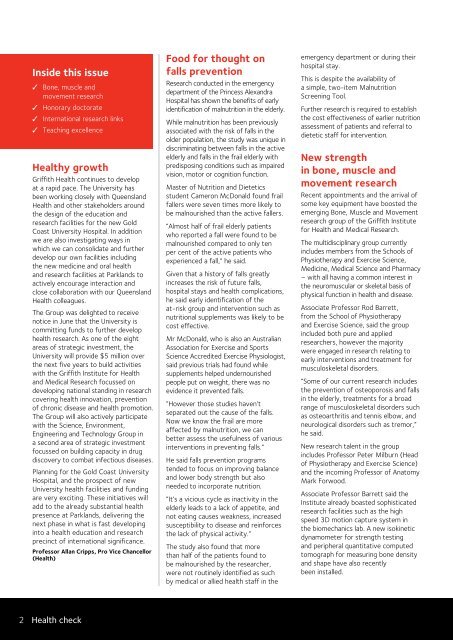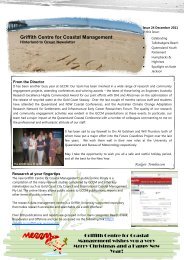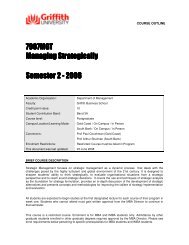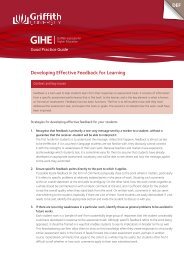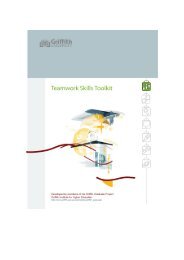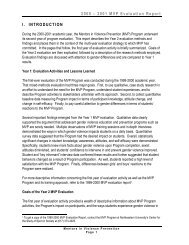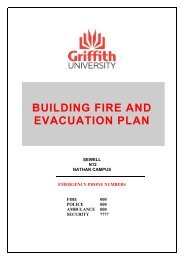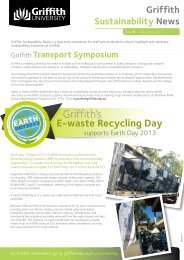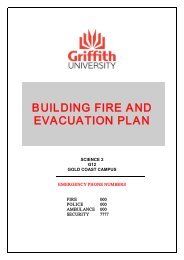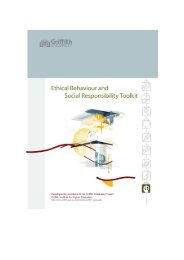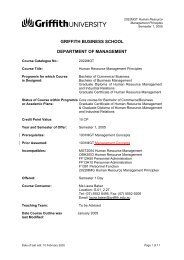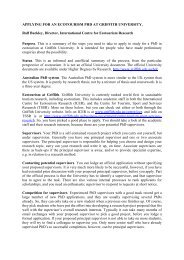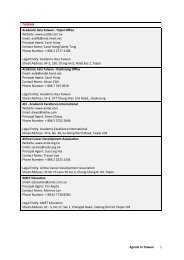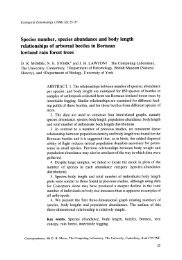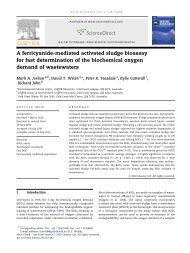Health Check Issue 19 2008 (PDF 283k) - Griffith University
Health Check Issue 19 2008 (PDF 283k) - Griffith University
Health Check Issue 19 2008 (PDF 283k) - Griffith University
You also want an ePaper? Increase the reach of your titles
YUMPU automatically turns print PDFs into web optimized ePapers that Google loves.
Inside this issue<br />
3 Bone, muscle and<br />
movement research<br />
3 Honorary doctorate<br />
3 International research links<br />
3 Teaching excellence<br />
<strong>Health</strong>y growth<br />
<strong>Griffith</strong> <strong>Health</strong> continues to develop<br />
at a rapid pace. The <strong>University</strong> has<br />
been working closely with Queensland<br />
<strong>Health</strong> and other stakeholders around<br />
the design of the education and<br />
research facilities for the new Gold<br />
Coast <strong>University</strong> Hospital. In addition<br />
we are also investigating ways in<br />
which we can consolidate and further<br />
develop our own facilities including<br />
the new medicine and oral health<br />
and research facilities at Parklands to<br />
actively encourage interaction and<br />
close collaboration with our Queensland<br />
<strong>Health</strong> colleagues.<br />
The Group was delighted to receive<br />
notice in June that the <strong>University</strong> is<br />
committing funds to further develop<br />
health research. As one of the eight<br />
areas of strategic investment, the<br />
<strong>University</strong> will provide $5 million over<br />
the next five years to build activities<br />
with the <strong>Griffith</strong> Institute for <strong>Health</strong><br />
and Medical Research focussed on<br />
developing national standing in research<br />
covering health innovation, prevention<br />
of chronic disease and health promotion.<br />
The Group will also actively participate<br />
with the Science, Environment,<br />
Engineering and Technology Group in<br />
a second area of strategic investment<br />
focussed on building capacity in drug<br />
discovery to combat infectious diseases.<br />
Planning for the Gold Coast <strong>University</strong><br />
Hospital, and the prospect of new<br />
<strong>University</strong> health facilities and funding<br />
are very exciting. These initiatives will<br />
add to the already substantial health<br />
presence at Parklands, delivering the<br />
next phase in what is fast developing<br />
into a health education and research<br />
precinct of international significance.<br />
Professor Allan Cripps, Pro Vice Chancellor<br />
(<strong>Health</strong>)<br />
Food for thought on<br />
falls prevention<br />
Research conducted in the emergency<br />
department of the Princess Alexandra<br />
Hospital has shown the benefits of early<br />
identification of malnutrition in the elderly.<br />
While malnutrition has been previously<br />
associated with the risk of falls in the<br />
older population, the study was unique in<br />
discriminating between falls in the active<br />
elderly and falls in the frail elderly with<br />
predisposing conditions such as impaired<br />
vision, motor or cognition function.<br />
Master of Nutrition and Dietetics<br />
student Cameron McDonald found frail<br />
fallers were seven times more likely to<br />
be malnourished than the active fallers.<br />
“Almost half of frail elderly patients<br />
who reported a fall were found to be<br />
malnourished compared to only ten<br />
per cent of the active patients who<br />
experienced a fall,” he said.<br />
Given that a history of falls greatly<br />
increases the risk of future falls,<br />
hospital stays and health complications,<br />
he said early identification of the<br />
at-risk group and intervention such as<br />
nutritional supplements was likely to be<br />
cost effective.<br />
Mr McDonald, who is also an Australian<br />
Association for Exercise and Sports<br />
Science Accredited Exercise Physiologist,<br />
said previous trials had found while<br />
supplements helped undernourished<br />
people put on weight, there was no<br />
evidence it prevented falls.<br />
“However those studies haven’t<br />
separated out the cause of the falls.<br />
Now we know the frail are more<br />
affected by malnutrition, we can<br />
better assess the usefulness of various<br />
interventions in preventing falls.”<br />
He said falls prevention programs<br />
tended to focus on improving balance<br />
and lower body strength but also<br />
needed to incorporate nutrition.<br />
“It’s a vicious cycle as inactivity in the<br />
elderly leads to a lack of appetite, and<br />
not eating causes weakness, increased<br />
susceptibility to disease and reinforces<br />
the lack of physical activity.”<br />
The study also found that more<br />
than half of the patients found to<br />
be malnourished by the researcher,<br />
were not routinely identified as such<br />
by medical or allied health staff in the<br />
emergency department or during their<br />
hospital stay.<br />
This is despite the availability of<br />
a simple, two-item Malnutrition<br />
Screening Tool.<br />
Further research is required to establish<br />
the cost effectiveness of earlier nutrition<br />
assessment of patients and referral to<br />
dietetic staff for intervention.<br />
New strength<br />
in bone, muscle and<br />
movement research<br />
Recent appointments and the arrival of<br />
some key equipment have boosted the<br />
emerging Bone, Muscle and Movement<br />
research group of the <strong>Griffith</strong> Institute<br />
for <strong>Health</strong> and Medical Research.<br />
The multidisciplinary group currently<br />
includes members from the Schools of<br />
Physiotherapy and Exercise Science,<br />
Medicine, Medical Science and Pharmacy<br />
– with all having a common interest in<br />
the neuromuscular or skeletal basis of<br />
physical function in health and disease.<br />
Associate Professor Rod Barrett,<br />
from the School of Physiotherapy<br />
and Exercise Science, said the group<br />
included both pure and applied<br />
researchers, however the majority<br />
were engaged in research relating to<br />
early interventions and treatment for<br />
musculoskeletal disorders.<br />
“Some of our current research includes<br />
the prevention of osteoporosis and falls<br />
in the elderly, treatments for a broad<br />
range of musculoskeletal disorders such<br />
as osteoarthritis and tennis elbow, and<br />
neurological disorders such as tremor,”<br />
he said.<br />
New research talent in the group<br />
includes Professor Peter Milburn (Head<br />
of Physiotherapy and Exercise Science)<br />
and the incoming Professor of Anatomy<br />
Mark Forwood.<br />
Associate Professor Barrett said the<br />
Institute already boasted sophisticated<br />
research facilities such as the high<br />
speed 3D motion capture system in<br />
the biomechanics lab. A new isokinetic<br />
dynamometer for strength testing<br />
and peripheral quantitative computed<br />
tomograph for measuring bone density<br />
and shape have also recently<br />
been installed.<br />
2<br />
<strong>Health</strong> check


